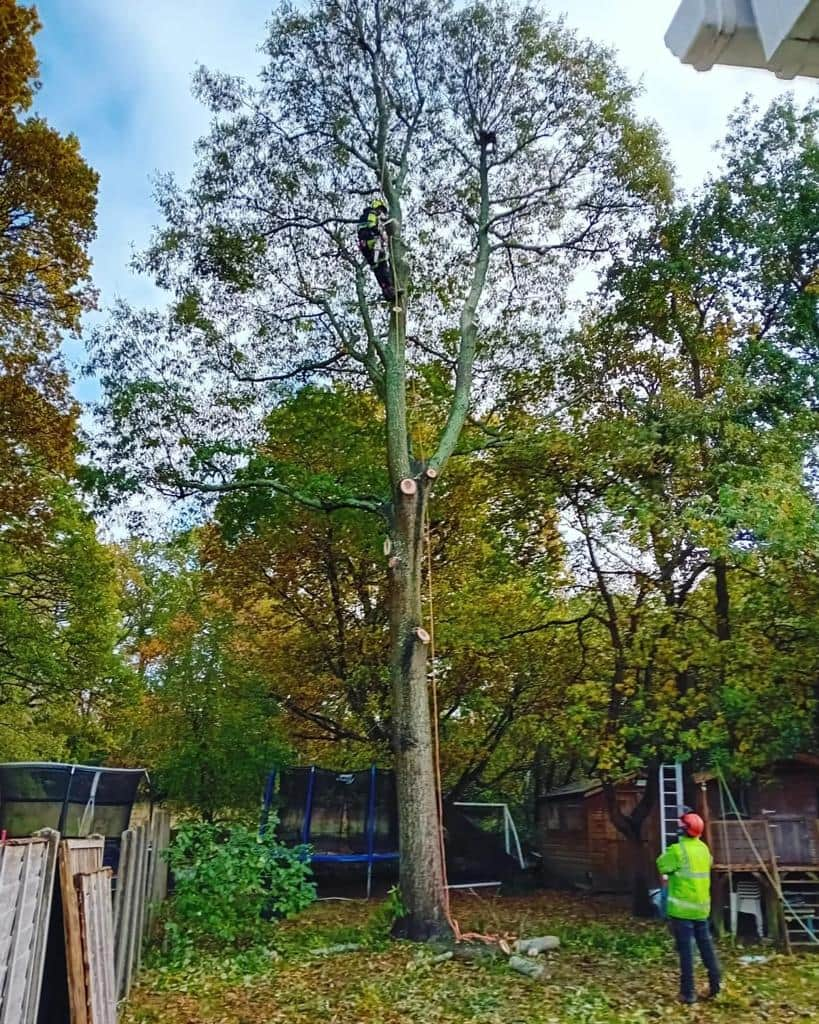Tree felling is one of the most significant and skilled operations within the field of arboriculture. Whether it’s removing a hazardous tree, clearing space for development, or managing woodland health, the process requires careful planning, precision, and experience. At NS Tree Surgery Cobham, we carry out professional tree felling across Cobham, Surrey, ensuring every job is performed safely, efficiently, and with respect for the surrounding environment.
Understanding Tree Felling
Tree felling is the controlled process of cutting down a tree to ground level. While it may appear straightforward, it involves a combination of technical skill, risk assessment, and understanding of tree biology. The way a tree is felled depends on factors such as its size, lean, root stability, and proximity to buildings, fences, or power lines.
Professional tree surgeons like NS Tree Surgery Cobham use specialist equipment and proven techniques to ensure that each tree is removed in the safest and most efficient manner possible.
When Tree Felling Is Necessary
There are various situations where tree felling becomes the best or only option. In most cases, it’s carried out for safety, environmental management, or property improvement reasons.
1. When a Tree Is Dead or Dying
A tree that has died or is severely decayed poses a serious risk to nearby people and property. Dead wood becomes brittle and unstable, increasing the likelihood of branches or the entire tree falling unexpectedly.
2. When a Tree Is Structurally Unsafe
Sometimes, trees suffer damage from storms, root decay, or disease. When their structural integrity is compromised and corrective pruning is not viable, felling may be necessary to prevent further damage or accidents.
3. To Prevent Damage to Property or Infrastructure
Trees with extensive root systems can interfere with underground utilities, driveways, or foundations. Likewise, overgrown canopies can cause problems for roofs, gutters, and nearby buildings. In such cases, strategic felling helps protect the property and prevent future damage.
4. For Site Development or Landscaping
Tree felling is often part of construction, extension, or landscaping projects where new structures or designs require open space. When handled correctly, it allows for controlled redevelopment while preserving surrounding vegetation.
5. To Promote Healthier Woodland Management
In woodland or estate settings, selective felling helps maintain biodiversity by reducing overcrowding. Removing certain trees allows sunlight to reach younger plants and encourages stronger, more diverse growth.
Choosing the Right Time for Tree Felling
Timing plays a crucial role in the success and environmental impact of tree felling. Certain periods of the year are more suitable for specific species or conditions.
Dormant Season (Late Autumn to Early Spring)
The dormant season is generally the best time for felling most trees. During this period, trees have less sap flow, meaning cuts are cleaner, and surrounding vegetation experiences minimal disruption.
Avoiding Nesting Season
From early spring to mid-summer, many bird species nest in trees and hedgerows. Responsible tree surgeons avoid felling during this time to protect wildlife habitats.
Assessing Weather Conditions
Tree felling should not be carried out during high winds or heavy rain. Calm, dry days ensure better control and visibility, allowing for a safer operation.
At NS Tree Surgery Cobham, we assess both seasonal timing and site conditions to determine the safest and most suitable time for every felling job.
How Tree Felling Should Be Done
The process of tree felling involves several steps to ensure a clean, controlled, and professional result.
1. Site Assessment and Planning
Before any work begins, a full risk assessment is carried out. This includes evaluating the tree’s lean, surrounding structures, escape routes, and the most effective cutting technique.
2. Selecting the Right Method
Depending on the environment, tree felling can be done in one of two ways:
- Straight felling: Cutting the entire tree to fall in one controlled direction, suitable for open areas.
- Sectional dismantling: Removing the tree in smaller, manageable sections using ropes and rigging equipment — ideal for confined spaces.
3. Making the Directional Cut
A directional notch (also known as the gob cut) is made on the side of the tree facing the desired fall direction. This guides the tree’s fall safely.
4. Back Cut and Controlled Fall
The back cut is made from the opposite side, releasing the tree and allowing it to fall in a controlled manner. Proper technique ensures precision and safety during this stage.
5. Clearing and Stump Management
After the tree has been safely felled, the trunk and branches are cleared from the site. The remaining stump can then be ground down to leave a smooth, level surface ready for replanting or landscaping.
The Importance of Professional Expertise
Tree felling requires not only the right equipment but also expert knowledge of tree structure, weight distribution, and cutting angles. Attempting to fell a tree without proper training can be dangerous.
At NS Tree Surgery Cobham, our team combines years of experience with modern techniques to ensure every job is carried out safely and efficiently. We handle everything from small garden trees to large, mature specimens with precision and care.
Aftercare and Site Restoration
Once a tree has been felled, proper aftercare ensures that the area remains safe and visually appealing. Common aftercare steps include:
- Stump grinding: Removing the stump to prevent regrowth and prepare the ground for reuse.
- Site clean-up: Clearing debris and leaving the site tidy.
- Replanting recommendations: Advising on replacement trees to maintain balance in the landscape.
This professional approach ensures the site looks well-managed and continues to support healthy vegetation.
Responsible Tree Felling in Cobham
Tree felling should always be approached with respect for both the property and the natural environment. At NS Tree Surgery Cobham, we take pride in delivering a balance between safety, efficiency, and environmental care. Our expertise ensures every tree is assessed individually, allowing us to recommend the most appropriate solution — whether that’s felling, pruning, or alternative management techniques.
Conclusion
Tree felling is sometimes necessary for safety, property protection, or environmental management — but it must always be performed with care, precision, and expertise. By understanding when, why, and how to fell a tree correctly, homeowners can maintain both safety and aesthetic value in their outdoor spaces.
For professional tree felling and expert arboricultural services in Cobham, Surrey, NS Tree Surgery Cobham provides reliable and experienced tree care that prioritises safety, precision, and long-term results.
Call us on: 01372 679 098
Click here to find out more about NS Tree Surgery Cobham
Click here to complete our contact form and see how we can help with your tree needs.

